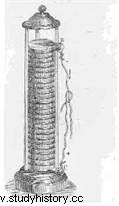 The invention of electricity , or rather the development of the science of electrification phenomena, was materialized by Coulomb's law (1785), allowing Volta to create the first electric battery (1800) then to Thomas Edison to light up factories and homes (1879). If the electrical phenomena have always existed and have been observed since antiquity, it was not until the end of the 18th century to theorize them, and the 19th century to master them.
The invention of electricity , or rather the development of the science of electrification phenomena, was materialized by Coulomb's law (1785), allowing Volta to create the first electric battery (1800) then to Thomas Edison to light up factories and homes (1879). If the electrical phenomena have always existed and have been observed since antiquity, it was not until the end of the 18th century to theorize them, and the 19th century to master them.
The discovery of electricity
The discovery of electricity , by observing the phenomena of electrification, is attributed to the Greek philosopher and scholar Thaies of Miletus , in the VIth century BC. AD :he had observed that a piece of amber rubbed vigorously acquired the property of attracting small light bodies to it, such as balls of elderberry marrow.
Subsequently, other substances with similar properties were discovered, and the mysterious force which thus manifested was named electricitas in 17th century scientific Latin (from the Greek word êlektron, "amber") and "electricity" in French, around 1733. And in 1752 Benjamin Franklin highlights the electrical origin of a second manifestation until then remained very mysterious:lightning and its impressive flashes.
These various observations and experiments have thus shown that the electrification of a body can be obtained in three ways:by friction , by contact with a body already electrified, or finally by influence , bringing it close enough to an already electrified body.
But if the discovery of electrical phenomena is one thing, their mastery and their conversion into energy is another one!
Who invented electricity?
Between 1785 and 1791, the French physicist Charles de Coulomb established the quantitative laws of electrostatic and magnetic attractions. He invented the torsion balance, which made it possible to accurately measure the forces exerted by electric and magnetic charges. Thanks to his balance, he formulates the law of attraction and repulsion of electric charges. On this principle, Volta built the first electric battery in 1800. To do this, he stacked copper and zinc discs alternately. Each pair is separated from its neighbor by a cloth soaked in salt water. Thanks to this assembly, he obtains a direct electric current. Then Peter Barlow , British mathematician and physicist, built the first electric motor (Barlow wheel, 1822). But it will take a little longer before electricity reaches homes.
 So it is the American Thomas Edison who takes care of it with the development in 1879 of a bulb "safe and cheap" and built the first power plant in Manhattan (a coal-fired turbine turning an alternator ), then in Paris (“City of Light”), London and Berlin. Thanks to these two major inventions, Edison is thus considered by many to be the "inventor" of electricity, although it would actually be more appropriate to quote Volta .
So it is the American Thomas Edison who takes care of it with the development in 1879 of a bulb "safe and cheap" and built the first power plant in Manhattan (a coal-fired turbine turning an alternator ), then in Paris (“City of Light”), London and Berlin. Thanks to these two major inventions, Edison is thus considered by many to be the "inventor" of electricity, although it would actually be more appropriate to quote Volta .
Soon after, the power replaces the steam to run more sophisticated machinery in factories . This is the second industrial revolution which begins, with among other variations the modern electric motors and batteries .
To go further on the history of electricity
- The fabulous history of inventions - From mastery of fire to immortality. Dunod, 2018.
- History of Electricity:From Amber to Electron, by Gérard Borvon. Vuibert, 2009.
